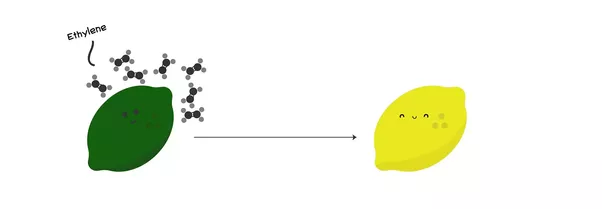เอทิลีนเป็นฮอร์โมนเร่งการเจริญเติบโตตามธรรมชาติที่ช่วยให้ผักและผลไม้สุกเร็วขึ้น บริษัทผลิตอาหารสดเชิงพาณิชย์ใช้เอทิลีนเพื่อเร่งกระบวนการบ่มผลไม้และผักในห้องบ่มผลไม้ที่ปิดสนิท ในความเข้มข้นที่ใช้ในห้องบ่มผลไม้ เอทิลีนไม่เป็นอันตรายต่อมนุษย์ อย่างไรก็ตาม เอทิลีนเป็นก๊าซที่ติดไฟได้ง่าย จึงเป็นปัญหาด้านความปลอดภัย
การใช้เอทิลีนเร่งกระบวนการบ่มผลไม้และผักสามารถช่วยให้บริษัทผลิตอาหารสดเชิงพาณิชย์สามารถตอบสนองความต้องการของตลาดได้อย่างทันท่วงที และเร่งการหมุนเวียนสินค้า อย่างไรก็ตาม ควรใช้เอทิลีนอย่างระมัดระวัง และปฏิบัติตามมาตรการความปลอดภัยอย่างเคร่งครัด
เซ็นเซอร์ตรวจจับเอทิลีนของ CETCI รุ่น AST-IS18 Industrial CO2 Transmitter สามารถช่วยติดตามระดับของเอทิลีนในห้องบ่มผลไม้ได้อย่างแม่นยำและต่อเนื่อง เซ็นเซอร์เหล่านี้ช่วยให้ผู้ประกอบการสามารถควบคุมกระบวนการบ่มผลไม้ได้อย่างมีประสิทธิภาพมากขึ้น เพิ่มความปลอดภัยในการทำงาน และป้องกันความเสียหายต่อผลผลิต
ดังนั้น การคอยตรวจสอบในปริมาณแก๊ส ทั้งเอทิลีน Ethylene (C2H4) และคาร์บอนไดออกไซค์ Carbon Dioxide (CO2) ในห้องบ่มผักและผลไม้นั้น จำเป็นและสำคัญอย่างยิ่งต่อการควบคุมคุณภาพสินค้า และการคำนึงถึงความปลอดภัยสำหรับมนุษย์ด้วย

Fruits and vegetables are commonly shipped for long distances from one country to another before they are ripe so they can endure the voyage and remain viable. Upon arrival at their destination, the first order of business is to get them ripe and ready for sale and consumption.
As fruit and vegetables ripen, they release ethylene, a naturally occurring growth hormone. To be profitable and meet demands, commercial fresh produce companies need to speed up the ripening process in a uniform and predictable way, which is achieved by adding more ethylene in a controlled environment. Typically, the fresh produce is placed in air‐tight ripening rooms and ethylene is introduced at concentrations between 10 and 1,000 ppm depending on the type of produce.
Ethylene is not harmful to humans in the concentrations used in ripening rooms. An extremely high level of ethylene would have to be inhaled in order to have an adverse effect on human health. That being said, ethylene is a very reactive and flammable gas, making the potential for an explosion a safety concern. The LEL for ethylene is 27,000 ppm (2.7%) and a common concentration used in a ripening room is 1,000 ppm (0.1% by volume), with a typical exposure time of 24 hours.
Two common ways to add ethylene to the ripening rooms is by high pressure gas cylinders or ethylene generators. If ethylene is delivered into the rooms by pipes from cylinders, there are areas for potential leaks and the threat of explosion from cylinders of pure ethylene is high.
Technologies Canada Inc. (CETCI)’s LPT-A-C2H4 Analog Transmitter with an electrochemical Ethylene sensor would be highly recommended to continuously monitor the ethylene gas levels in the cylinder storage room. The information gathered by the sensor is viewable on the LCD display of the LPT-A-C2H4 transmitter. If a leak is detected, the relay in the LPT-A-C2H4 can quickly switch off the gas cylinders or ethylene generators.
In the ripening rooms, the primary reason for an ethylene gas detector is not for the safety of humans, but rather for the safety of the perishable goods. Assisted ripening is a complex process and predictions can be made about the remaining shelf life of the perishable goods based on the level of ethylene gas that is present; that the produce gives off. Some types of fruits and vegetables are more sensitive to ethylene than others. Ethylene sensitive produce will spoil if exposed to levels that make them ripen too quickly. Varieties that are more tolerant but don’t get the right amount will not ripen on schedule.
There is also the potential for ethylene to leak from one room into another, especially if the method of delivery is through a network of pipes. This could cause premature ripening or result in damage to the other types of produce in adjacent rooms. Monitoring the concentration levels of the ethylene gas in each room will help ensure the correct amount is being delivered at all times.
As fruit ripens, it releases carbon dioxide. This decreases the oxygen level in the room and delays the effects of the ethylene. CO2 levels in excess of 1% (10,000 ppm) will slow the ripening process, and can cause quality and production problems. When CO2 levels build up, the ripening room should be vented, which could be as simple as opening the door, or turning on a ventilation system. Constant monitoring of the CO2 levels inside the room with CETCI’s AST-IS18 Industrial CO2 Transmitter with a nondispersive, infrared CO2 sensor that can be configured to activate the ventilation system at a predefined concentration allowing for a more efficient control and optimization of the ripening process, a higher safety level and better production.
หากท่านใดสนใจเกี่ยวกับการใช้เอทิลีนเร่งกระบวนการบ่มผลไม้และผักอย่างปลอดภัยและมีประสิทธิภาพ (Using ethylene to ripen fruits and vegetables safely and efficiently) สามารถติดต่อเราได้ที่นี่

